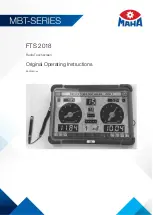
4
Instructions for installation and use
S 22
DKDHR
VI.IE.D1.02
Danfoss District Energy
3.
Enduser instructions, description and initial adjustment
Instructions
Please read these instructions carefully before installing and com-
missioning this unit. The manufacturer accepts no liability for loss
or damage resulting from failure to comply with these instructions
for use. Read and follow these instructions carefully to prevent the
risk of physical injury and/or damage to property. Exceeding the
recommended operating parameters appreciably increases the risk
of personal injury and/or damage to property.
Installation, commissioning and maintenance must be carried out
by qualified and authorised personnel (both plumbing and electri-
cal work).
Once the station has been installed and is operating, there is
nor-
mally
no need to alter the settings or other functions. The district
heating unit is very reliable and easy to operate.
Description
These instructions apply to S 22 with Danfoss ECL Comfort 310 con-
troller for control of both the heating circuit as well as a domestic hot
water circuit based on an instantaneous water heater (Application
A266).
S 22 units are fitted with a differential pressure controller that main-
tains a constant pressure in the radiators. The supply temperature to
the heating circuit is controlled electronically, and also the domestic
hot water temperature is controlled electronically.
We recommend regular inspections of the unit - ideally in connection
with readings of the district heating meter.
Pay special attention to any leaks and an excessively high return
temperature in the district heating circuit (poor cooling of the district
heating water). Cooling – i.e. the difference between the supply and
return temperature of the district heating water – has a significant
effect on the overall energy economy. Please note that the district
heating return temperature is directly related to the return tempera-
ture from the heating circuit (and the return temperature from the
DHW plate heat exchanger). Therefore, it is important to focus on the
supply and return temperature in the heating system.
The difference should typically be 30–35°C in systems that operate
with radiators. In systems that feature floor heating, the difference
is typically 5–10°C.
Initial setting
S 22 is electronically controlled (fully automatic) and there is nor-
mally no need to alter the settings or other functions. The DHW
and HE temperatures are set during initial adjustment and com-
missioning of the unit.
We suggest that you contact qualified and authorised personnel,
if it becomes necessary to change the parameters (temperatures,
Irregularities
When reading the meter, check all joints and connections for leaks.
If you identify any irregularities/leaks, contact your professional
provider for assistance.
Warning! Hot surfaces
Parts of the unit may be very hot and can cause burn injuries.
Be very careful when you are in the immediate vicinity of the unit.
Warnings about high pressure and high temperature
The maximum supply temperature in the district heating net-
work can be up to 120°C and the operating pressure can be up
to 16 bar. This may result in a risk of scalding from touching the
unit and from outflow of the medium (water/steam). Exceeding
the unit design data and operating parameters for pressure and
temperature carries an appreciable risk of personal injury and/or
damage to property.
Emergencies
In the event of fire, leaks or other hazards, immediately shut off
all sources of energy to the unit, if possible, and call for appropri-
ate assistance.
If the domestic hot water is discoloured or malodorous, shut off
all ball valves on the unit notify all users and call for professional
assistance without delay.





































